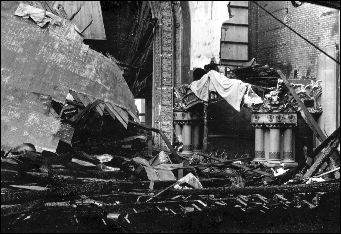| |||||
Tinkham, on the loss of the Modesto Theater, to a 1913 fire:
"The loss of the pretty little playhouse was greatly deplored by the citizens and a number of progressive men sympathizing with Mr. Mensinger offered to form a company and rebuild the interior. He declined the generous offer with thanks and stated that he would immediately begin the rebuilding of the temple of Orpheus and Momus... . .The new lessee was A. A. Richards, a theatrical manager of experience and at one time owner of the Modesto Star theater. The decorative work and the painting of the scenery was given to a Los Angeles firm and the geral scheme of decorations was old rose, blue and gold. The modern style of lighting was introduced and the electrical globes placed under cover produced the effect of quiet richness rather than gorgeousness and splendor. One of the first things to attract the eye as you enter the theter is the large painting which occupies the entire space of the proscenium. It is a painting by Hurt of Los Angeles and represents the artist's idea of Faust as portrayed in Goethe's wonderful drama. The theater was completed and rededicated July 9, 1914."
THE MODESTO THEATER
(Opened Feb. 6, 1913; interior destroyed by fire Dec. 9, 1913; reopened, July 2, 1914; Closed by fire Aug. 12, 1935.)
927 10th Street
The first playhouse that could rival those in bigger cities was built by Willliam E. Mesinger. In TInkham's, "History of Stanislaus County," the local historian proclaims that among Modesto's progressive men "none were more progressive" than Mensinger.
"Believing that a modern, up-to-date theater would not only be a good investment, but an attractive pleasure resort for the citizens of the city and the surrounding county, in 1911 he concluded to invest at least $100,000 in the building of a first-class dramatic and operatic theatre. . .A Stockton architect was then employed to draw the plans of a first-class place of entertainment."
The Modesto Theatre opened on February 6, 1913, with Gilbert and Sullivan's, "The Pirates of Penzance." An advertisement in the Modesto Evening News also said the theater showed ‘The Cream Of Motion Pictures’. The new building was built on the former site of the Star Theater, which had moved across the street to 928 10th Street.
The original theater is often referred to as a "dollhouse." It was grandly outfitted with marble, rich rugs and a sense of "gorgeousness and splendor," according to Tinkham. On December 9, 1913, a fire estimated to cause $30,000 in damage destroyed the Modesto Theatre interior. The next day Mensinger announced plans to rebuild and said the venue would be bigger and better. The Modesto Theatre reopened on July 9, 1914, with the movie "From the Manger to the Cross." The National Theatre Syndicate took over operation of the Modesto Theater in 1925. The ccompany was a major Northern and Central California film distributor.
On August 12, 1935, another fire damaged the theater and plans were immediately put into place to rebuild. Those plans did not come to fruition and by September, 1936 a building permit was taken out to remodel the former theater into stores, reducing the building from three stories to one. By this time, Modesto had other major theaters including the Strand, the Lyric, the Princess and the recently opened State.
The building still stands in downtown Modesto, though, after a stint as the Copper Rhino bar and nightclub, it is empty. The front of the building was modernized, covering the brick facade with stucco. The front third of the structure was lowered and the balcony removed in 1936. The building lacks its bygone character, but has been used for various commercial stores since 1936. It has outlasted many other landmarks in Modesto.
Today, the only evidence of its former existence is the stage loft area at the back of the building. It still rises at an angle to the back wall, making the building look uniquely bulky when compared to other buildings on the block.
The Modesto Theater - Opening Night
The opening event was a production of Gilbert and Sullivan's "The Pirates of Penzance" by the Modesto Choral Society. The cast is shown above. Note that, in the practice of the day, several players are shown in blackface, something since banished from modern stages. There were 90 voices in the chorus plus an orchestra under the direction of Professor J. D. Twicher, according to Tinkham's history. Professional touring companies also played the Modesto Theater, with a production of "The Prince of Pilsen" in March. On December 6, 1913 the Whitney Opera Company presented Victor Herbert's operetta, "The Chocolate Soldier." Sunday afternoon the Elks held their first memorial service in the theater and that Monday evening, December 9, the theater's manager opened the door and found the auditorium filled with smoke. Before the fire department could extinguish the flames, the interior was gutted, causing $30,000 in damage. |



